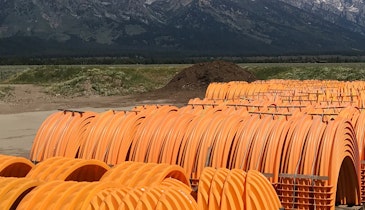Interested in Flow Control?
Get Flow Control articles, news and videos right in your inbox! Sign up now.
Flow Control + Get AlertsInflow and infiltration, a sequencing batch reactor unable to handle peak flows, and high BOD levels from two schools and a bakery caused effluent from the Rimersburg Borough (Pa.) Municipal Authority wastewater treatment plant to exceed permit levels.
The result was a proposed consent order and agreement from the state Department of Environmental Protection. Even though the authority had reduced I&I by 35 percent and flow monitors showed that the facility was handling the load, the DEP insisted that two adjacent communities build a pretreatment plant.
The authority agreed that would solve organic and system issues, but officials objected to what the expansion would cost its 500 customers. “Constructing a $3 million facility would be worse than a fine to a community this small,” says Roger Crick, authority chairman.
Crick, determined to have more control of the process and agreements, called borough engineering consultant, Ken Orie, P.E., project engineer for Gibson-Thomas Engineering Co. Inc., in Latrobe, Pa. Crick suggested televising all 26,000 feet of the collection system to prove the authority’s willingness to manage its assets. It was only three weeks before the final negotiation meeting with the DEP.
Orie recommended leasing a Solo robotic pipe inspection system from RedZone Robotics. In five days crews began launching the units, and the inspection was completed. The results enabled the authority to avoid a consent order and fine.
Expedited benefits
For years, budget constraints had limited the authority’s efforts to maintain its sewers and develop a rehabilitation program. When Gibson-Thomas Engineering first monitored I&I flows, they averaged 0.108 mgd, including a maximum daily level of 0.6 mgd during 2.75 inches of rain. “We reduced I&I through lateral replacement and other structural measures, but we still lacked enough system knowledge to understand its effects on plant performance,” says Crick.
The treatment plant, embedded into a hillside, has no headworks. Most sewers are 8- to 12-inch lines, and distances between the 200 manholes often exceed 500 feet. “The best footage a five-man crew can get with conventional inspection systems is 1,000 feet per day, and we didn’t have 26 days,” says Orie. “With Solo, one technician can operate four battery-powered robots simultaneously, increasing throughput three to five times.”
Sam Cancilla, regional sales vice president for RedZone, and Orie taught public works foreman Frank McNaughton and his assistant how to operate the system. It includes fully autonomous robotic crawlers, camera platform, image capture, data storage, interpretation, comprehensive condition reports, and access to interactive online asset management tools. Cancilla also provided coding and characterization services according to NASSCO Pipeline Assessment and Certification Program (PACP) standards.
The package
The fore-and-aft cameras have a 360-degree field of view with LED light arrays around the lenses. The panoramic view ensures a thorough inspection. “When technicians push past something using conventional technology, they can’t look back,” says Orie. “The rear camera solves that problem and produces symmetrical data capture.”
The crawler has a pair of 2-inch-wide orange treads and a back plate with a small-diameter cord tied in a loop. The cord is part of the control and retrieval system. Working independently, McNaughton and his assistant launched the crawlers by positioning a telescoping compression-secured hanger bar at the top of the manhole just below the lid-supporting lip. Then they slipped the short cord through a lightweight anti-chafing guide on the hanger bar before lowering the units, using a telescoping deployment pole with hook.
They deployed a robot per line entering the manhole, transmitting location and pipe information to each unit’s onboard computer using an armored laptop computer with WiFi. Once the manhole lid was replaced, the hanger bar became the reference point from which the units measured their surroundings and interpreted their situation.
Once in the flow, the crawlers were free of human interaction until they were retrieved. Sensors in the pressurized bodies kept them centered in the channel and stopped them upon detecting the open space of the next manhole.
A reel in the back of the body maintained slight tension on the cord as part of the condition-sensing system. “The cameras photograph the manhole chimney before the robot returns to the insertion manhole,” says Orie. “The treads disengage and the unit hoists itself up the cord until it is suspended just below the hanger bar.”
After retrieving the crawlers, the men used their laptops to verify the camera views and captured images. Then they cleaned the robots using a garden-type sprayer and specified degreaser. The unit’s rechargeable batteries can power two 400- to 500-foot runs at up to 30 feet per minute before needing replacement.
A redundant mass data storage unit, called the Vault, automatically downloaded the data and images using Ethernet cable connections. The system has 16 GB of onboard data storage capacity, enough for about 10,000 feet of inspections. Data from the Vault was stored on a palm-sized hard drive, then sent to the RedZone Robotics office, where reporting technicians did condition assessments.
Mission accomplished
By avoiding the typical setup of cleaning and televising, the authority saved money and time. The crew completed the inspection in five days. “The portable units eliminated easement access issues and minimized public disruption,” says Crick. “The virtual video allowed us to review the entire inspection off-line as if we were operating a camera in real time.”
After DEP officials reviewed the authority’s efforts to improve its collection system management, they removed the consent order and canceled the requirement to construct a $3 million pretreatment plant.





